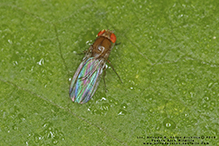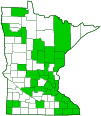Spotted-wing drosophila (SWD)
(Drosophila suzukii)
Conservation • Description • Habitat • Ecology • Distribution • Taxonomy
Conservation Status |
|||
| IUCN Red List | not listed |
||
| NatureServe | NNA - Not applicable |
||
| Minnesota | not listed |
||
Description
Spotted-wing drosophila is a small, invasive, vinegar fly. It is native to southeast Asia but has been rapidly spreading around the world. It was seen in Japan as early as 1916, and by the 1930s it had spread throughout eastern Asia. In North America it was first seen on the west coast in 2008 and on the east coast in 2010. It was first recorded in Minnesota in 2012. It has been much studied, written and talked about, and is commonly referred to by the acronym SWD. It can be found from spring through fall in agricultural fields, orchards, and gardens, and year round in kitchens.
SWD is a serious crop pest of summer fruits, including cherries, blueberries, grapes, nectarines, pears, plums, pluots, peaches, raspberries, and strawberries. Unlike fruit flies, which feed on decaying fruit and vegetation, SWD lays its eggs on healthy fruit.
Adults are yellowish, 5⁄64″ to 9⁄64″ (2 to 3.5 mm) in length, and look like fruit flies.
The head is yellowish-brown. There are two large compound eyes on the sides of the head and three small simple eyes (ocelli) in a triangle on top of the head. A pair of bristles (setae) behind the ocellar triangle (postocellar setae) are well developed. The compound eyes are red. They do not meet at the top of the head on either sex. The upper part of the face has sparsely scattered bristles. On each side, near the margin of the compound eye, there are two bristles. One is bent down at the base (reclinate seta), the other is bent upward at the base (proclinate seta). The proclinate seta is larger and is above and slightly outside of the reclinate seta. There are two stiff, well-deveolped bristles (vibrissae) below the antenna bases. There is a ridge (carina) in the middle of the face. The carina is broad and well developed, including on the lower part of the face. The antennae are very short and have three segments. The second segment does not have a longitudinal groove (suture) on top. The third segment has a long, forward-pointing bristle (arista) on the upper side. The arista is branched (plumose), with several branches above and two or three branches below.
The thorax is yellowish-brown above and on the sides, with no stripes or spots. It has three segments. Each segment has four principal exoskeletal plates, one above, one below, and one on each side. The upper (dorsal) plates, from front to rear, are the prescutum, scutum, and scutellum. The prescutum and scutum have several large black bristles and numerous shorter hair-like bristles. There are eight longitudinal rows of small bristles in the middle of the scutum, and two pairs of large bristles near the rear margin. The lower front plate of the middle segment (katepisternum) has three large bristles.
The abdomen has six visible segments on both the male and female. On the female, segments 2 through 6 are pale yellow with an unbroken, dark band on the rear margin. On the male segments 2 through 4 are similar to the female, segments 5 and 6 are completely dark.
The wings are clear. Their is a vein (costa) on the leading edge (costal margin) of the wing. The costa is broken twice. On the male there is usually a dark cloudy spot at the end of each radial vein R2+3 and R4+5. This is the feature that gives the fly its common name. On the female the wings are clear with no dark spots or white markings.
The legs are yellow. The last part of the leg, corresponding to the foot (tarsus) has five segments. The first segment is longer than the second, and is not swollen. On the front leg of the male there is a black comb on the first and second segments. The comb on the first segment has 4 to 6 teeth, the comb on the second has 2 or 3 teeth.
Size
Total length: 5⁄64″ to 9⁄64″ (2 to 3.5 mm)
Similar Species
Habitat
Agricultural fields, orchards, gardens, and kitchens
Ecology
Season
Up to 13 generations per year: Year-round
Behavior
Life Cycle
Larva Food/Hosts
Adult Food
Distribution |
||
|
Sources Biodiversity occurrence data published by: Minnesota Biodiversity Atlas (accessed through the Minnesota Biodiversity Atlas Portal, bellatlas.umn.edu, 9/30/2025). EDDMapS. 2025. Early Detection & Distribution Mapping System. The University of Georgia - Center for Invasive Species and Ecosystem Health. Available online at http://www.eddmaps.org/; last accessed October 1, 2025. |
|
| 9/30/2025 | ||
Occurrence |
||
Common and increasing in Minnesota |
||
Taxonomy
Order
Suborder
Brachycera
Infraorder
Cyclorrhapha
Zoosection
Schizophora
Zoosubsection
Acalyptratae (acalyptrate flies)
Superfamily
Ephydroidea
Family
Drosophilidae (pomace flies, small fruit flies, and vinegar flies)
Subfamily
Drosophilinae
Tribe
Drosophilini
Genus
Drosophila (small fruit flies)
Subgenus
Sophophora
Species group
melanogaster group
Species subgroup
suzukii subgroup
Subordinate Taxa
Synonyms
Drosophila indicus
Leucophenga suzukii
Common Names
cherry vinegar fly
spotted-wing drosophila
spotted-winged drosophila
SWD
Glossary
Arista
A large bristle on the upper side of the third segment of the antenna of a fly. Plural: aristae.
Carina
An elevated keel or ridge.
Costa
On ferns: The central axis of a pinna, to which pinnules are attached. On mosses: the central axis (midvein) of a leaf. On insects: The vein on the leading edge of the forewing.
Costal margin
The leading edge of the forewing of insects
Frons
The upper front part of an insect’s face, roughly corresponding to the forehead.
Ocellus
Simple eye; an eye with a single lens. Plural: ocelli.
Scutellum
The exoskeletal plate covering the rearward (posterior) part of the middle segment of the thorax in some insects. In Coleoptera, Hemiptera, and Homoptera, the dorsal, often triangular plate behind the pronotum and between the bases of the front wings. In Diptera, the exoskeletal plate between the abdomen and the thorax.
Scutum
The forward (anterior) portion of the middle segment of the thorax (mesonotum) in insects and some arachnids.
Seta
A stiff, hair-like process on the outer surface of an organism. In Lepidoptera: A usually rigid bristle- or hair-like outgrowth used to sense touch. In mosses: The stalk supporting a spore-bearing capsule and supplying it with nutrients. Plural: setae. Adjective: setose.
Tarsus
On insects, the last two to five subdivisions of the leg, attached to the tibia; the foot. On spiders, the last segment of the leg. Plural: tarsi.
Visitor Photos
Share your photo of this insect.
This button not working for you?
Simply email us at info@MinnesotaSeasons.com.
Attach one or more photos and, if you like, a caption.
Alfredo Colon |
 |
MinnesotaSeasons.com Photos
|

Slideshows

Visitor Videos
Share your video of this insect.
This button not working for you?
Simply email us at info@MinnesotaSeasons.com.
Attach a video, a YouTube link, or a cloud storage link.
Other Videos
Drosophila Suzukii and native European parasitoids
agroscopevideo
How to Identify and Trap Spotted Wing Drosophila
Utah State University Extension
How to Identify Spotted Wing Drosophila Damage
The University of Maine



